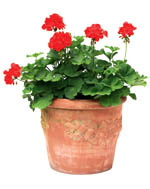Gardening tips: late November
Prune climbing roses, buy mycorrhizal fungi, choose local fruit trees and pot-on your geranium cuttings


Prune climbing roses
Go ahead with pruning your climbing roses now. The most important part of training roses is the tying in to the framework of new branches that haven’t yet flowered, and pruning back spent and redundant branches. The best way to learn is by watching an expert prune a rose; if you’re new to it, perhaps you could persuade a local head gardener or rose enthusiast to show you how it’s done. If not, then visit a garden open to the public through the year and look carefully at how the roses have been pruned.
Buy mycorrhizal fungi
You can now buy a packaged form of this naturally occurring fungus, under the name of Rootgrow (sold at many garden centres around the country, or available from www.friendlyfungi.co.uk). It establishes a symbiotic relationship with plant and tree roots in which each supply to the other sugars and other nutrients that they can’t produce on their own. We were lucky enough to experience this in the natural form when, in 1991, we planted a roundel of oaks in ancient parkland, next to a mature tree. It was soon obvious that the young trees closest to the old oak (with its associated root fungi) were growing more strongly than those at a distance from it. We planted a second roundel five years ago, again next to an old tree; each young oak was put in the ground together with soil and leaf mould taken from oak woodland. The second roundel has much more even growth than the first. So, if you’re planting in virgin or newly dug ground, I would recommend buying mycorrhizal fungi specifically for shrubs, trees and, in particular, if you’re replacing roses.
Choose local fruit trees
Fruit-tree growers will be starting to lift field-grown trees shortly, and they will soon be on sale in garden centres or by mail order. Prepare the sites for your new trees before they arrive. Research beforehand will pay dividends, as you’re likely to find that local varieties bred over generations will suit the climate and conditions in your area, a factor that becomes more important in northern areas. Take care to protect your young trees from rabbits, hares and deer. Purpose-made tree guards are easily available, or make your own with wire netting bent into a circle, making sure it’s at least 2ft in height, higher if you have deer. However, be careful not to let the protection rub against the bark of the tree.
Pot-on geraniums
Exquisite houses, the beauty of Nature, and how to get the most from your life, straight to your inbox.
You can pot-on your geranium cuttings now, if they’re in a heated greenhouse; they will then carry on growing through the winter. By the spring, they’ll be better plants than if you’d left them to overwinter in their original trays or pots. Avoid watering pot plants using cold water drawn directly from external water butts. Instead, bring one or two buckets of water indoors to warm up first. Philip Maddison is head gardener at Harrington Hall, Lincolnshire, www.harringtonhallgardens.co.uk
Country Life is unlike any other magazine: the only glossy weekly on the newsstand and the only magazine that has been guest-edited by His Majesty The King not once, but twice. It is a celebration of modern rural life and all its diverse joys and pleasures — that was first published in Queen Victoria's Diamond Jubilee year. Our eclectic mixture of witty and informative content — from the most up-to-date property news and commentary and a coveted glimpse inside some of the UK's best houses and gardens, to gardening, the arts and interior design, written by experts in their field — still cannot be found in print or online, anywhere else.
